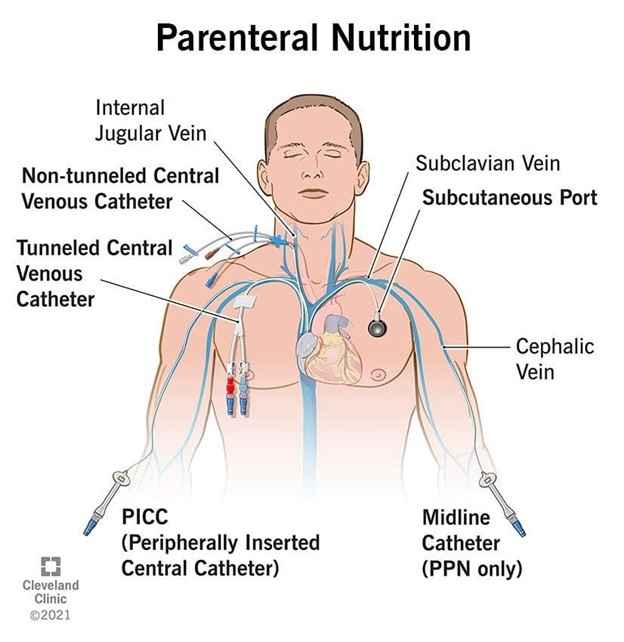A nurse is teaching a client who has a new prescription for total parenteral nutrition through a central line. Which of the following information should the nurse include in the teaching?
"I will change your IV tubing once every 48 hours."
"Abdominal distention is an expected effect of this therapy."
"I will need to check your gastric residual before administering feedings."
"I will need to measure your weight daily."
The Correct Answer is D

- A is incorrect because IV tubing for total parenteral nutrition should be changed every 24 hours to prevent infection.
- B is incorrect because abdominal distention is not an expected effect of total parenteral nutrition. It could indicate a complication such as fluid overload or bowel obstruction.
- C is incorrect because gastric residual is not relevant for total parenteral nutrition, which bypasses the gastrointestinal tract.
- D is correct because weight measurement is an important indicator of fluid balance and nutritional status for clients receiving total parenteral nutrition.
Nursing Test Bank
Naxlex Comprehensive Predictor Exams
Related Questions
Correct Answer is C
Explanation
Choice A rationale:
Repositioning the NG tube is not the appropriate action for hyperosmolar dehydration. This condition occurs due to an excessive concentration of solutes in the body, leading to a decrease in intracellular water. Repositioning the tube would not address the hyperosmolarity issue.
Choice B rationale:
Increasing the rate of formula delivery may exacerbate the problem by introducing more concentrated formula into the client's system, worsening hyperosmolarity. This choice can lead to further dehydration and electrolyte imbalances.
Choice C rationale:
Adding water to the formula is the correct action in this scenario. Hyperosmolar dehydration requires dilution of the concentrated formula to reduce the osmolarity. By adding water to the formula, the nurse can decrease the concentration of solutes, helping to rehydrate the client effectively.
Choice D rationale:
Switching to a lactose-free formula is not the appropriate intervention for hyperosmolar dehydration. The issue lies in the concentration of the formula, not in its lactose content. Adding water is the more suitable and direct approach to address the problem.
Correct Answer is D
Explanation
Choice A rationale:
The provider does not choose a client's healthcare surrogate. Advance directives, including the appointment of a healthcare surrogate, allow individuals to make their own decisions about their medical treatment if they become unable to communicate their wishes. Clients have the right to designate their healthcare surrogate based on their preferences and values. This statement is incorrect as it misrepresents the purpose of advance directives.
Choice B rationale:
A healthcare surrogate does not need to be a family member. The choice of a healthcare surrogate is a personal decision made by the individual. It can be a family member, friend, or any other person whom the individual trusts to make medical decisions on their behalf. There is no requirement that the surrogate must be a family member.
Choice C rationale:
The provider cannot go against the client's wishes regarding advance directives. Advance directives are legally binding documents that outline the individual's preferences for medical treatment, including decisions to withhold or withdraw life-sustaining interventions. Healthcare providers are ethically and legally obligated to respect and follow the directives outlined by the client. Going against the client's wishes would be a violation of their autonomy and legal rights.
Choice D rationale:
The client can resume control of healthcare decisions after a temporary loss of competency if specified in the advance directives. Advance directives often include provisions stating that the individual's decision-making capacity should be
Whether you are a student looking to ace your exams or a practicing nurse seeking to enhance your expertise , our nursing education contents will empower you with the confidence and competence to make a difference in the lives of patients and become a respected leader in the healthcare field.
Visit Naxlex, invest in your future and unlock endless possibilities with our unparalleled nursing education contents today
Report Wrong Answer on the Current Question
Do you disagree with the answer? If yes, what is your expected answer? Explain.
Kindly be descriptive with the issue you are facing.
